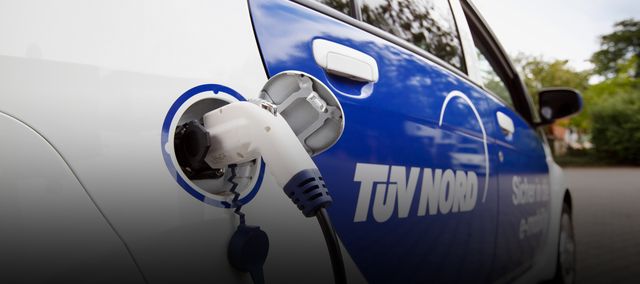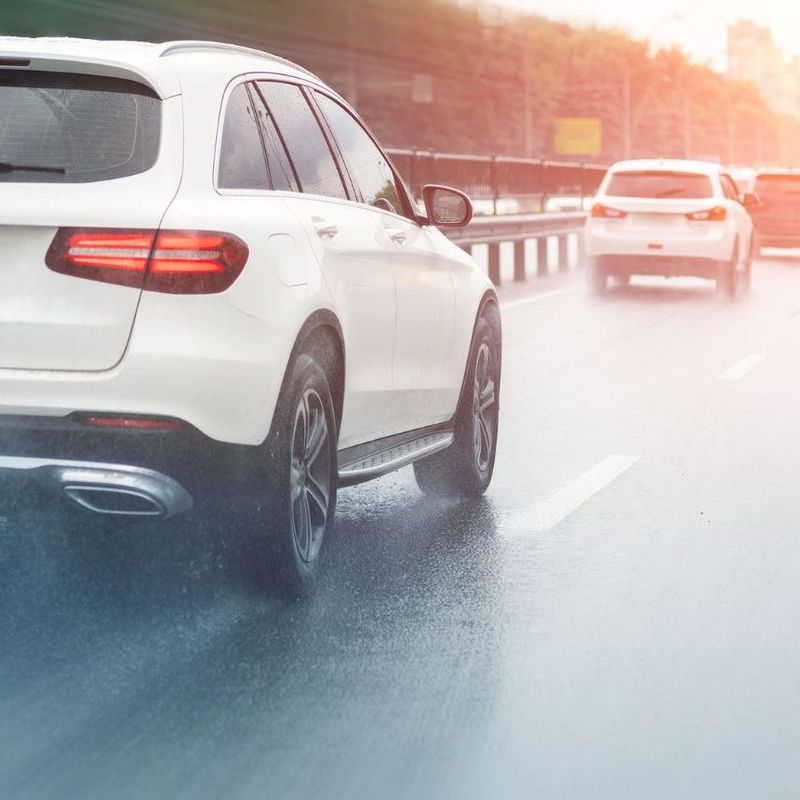7 December 2017
How suitable for everyday use are electric cars today, how eco-friendly are these vehicles, what developments can we expect and how can electric cars be made suitable for mass use? These are the questions discussed by TÜV NORD expert Christian Förster in this interview with #explore.
#explore: Everyone is talking about electromobility. But despite this, many people in Germany have not yet driven an electric car. When did you get behind the wheel of an electric car for the first time?
Christian Förster: That was about seven years ago. In 2009, electromobility was promoted by politicians and there were great expectations, and at that time TÜV NORD GROUP decided to support the objectives of the German government. As I am primarily responsible for new technology and services, I was affected – and I was not particularly happy about it. I originally studied mechanical engineering, because I wanted to have hands-on contact with engines. Electric vehicles with high-voltage technology and magnetic fields, which you cannot see and are not allowed to touch, were initially not my area of choice. My starting point is the combustion engine and I have worked intensively in the area of emissions reduction. And now I have a car which does not even have an exhaust pipe and which does not need this complex and costly exhaust gas cleaning system. And in fact it started to fascinate me after I had gone through a certain learning phase.
#explore: How has your attitude to electric cars changed?
Christian Förster: I was very quickly convinced by the electric car concept. Any electric car is superior in every respect to a car powered by an internal combustion engine when it comes to performance and acceleration, torque, the emissions balance and simplicity of driving. The battery is simply the most efficient drive system in order to generate a great deal of mobility with relatively low use of resources. The only thing which is missing for me is the sonorous roar of a V8 engine. This has something to do with the hidden Neanderthal in me!
#explore: Many people are afraid that an electric car does not offer the same comfort as a conventionally-powered car when it comes to everyday driving: they think that the range is insufficient or the heating will only run at half power in winter. What are your experiences?
Christian Förster: In seven years and having driven well over 200,000 electrically-powered miles, I have never once been stuck at the side of the road. But it is true, at the beginning the cars were very spartan indeed. I once had to get behind the wheel in winter wearing my anorak. And the fear that I might not arrive at my destination was always in the background. But now a great deal has improved with regard to comfort, range and everyday usability. In 2013 we also decided to buy an electric vehicle as a private family car.
© TÜV NORDThe TÜV NORD operates in Hanover its own solar charging station for electric cars.
#explore: In which areas is an electric vehicle already suitable for everyday use?
Christian Förster: It does not make any sense at all to buy an electric car to salve your “green” conscience and then to use it just for occasional shopping trips. We should not be tempted to buy a “get out of jail card” in the form of an electric car. Currently, more energy is needed to produce an electric vehicle than to manufacture a vehicle powered by a modern combustion engine. And this again means that an electric car has to travel as many kilometres as possible in order to redress the balance. When we decided to purchase an electric car for private use, it was clear from the start that it would be our primary vehicle. And we were able to achieve this from the very first year, because naturally we have the advantage that I have a charging post both at work and at home. This means that daily journeys of up to 300 kilometres are possible, even if the battery charge only lasts for 100 kilometres. In our family, the favourite car is the electric one – because it is the easiest to drive and the range of 100 kilometres is usually quite sufficient. Today, an electric car is already entirely capable of covering 90 per cent of mobility needs. And it is possible to use alternatives for the other ten per cent. For long distances I can always use the train, a hire car or a second car (if I have one), or I can fly. But you still have to really want to change to electromobility from the easy and comfortable means of transport you are used to.
#explore: The German government wanted to have one million electric cars on German roads by 2020. But we are still a long way away from achieving this target. In the medium term, electric cars should even replace conventionally-powered vehicles. What would need to happen politically, technically and from the infrastructure point of view for this to become possible?
Christian Förster: It is a question of range, energy charging infrastructure and price. Even a Tesla is only financially worthwhile when set against high-end vehicles, and not everyone wants or is able to buy one of these. On the political side, there is a clear commitment to electric vehicles, because we have to fulfil our CO2 obligations. From the manufacturer’s viewpoint, the problem is that profits are difficult to achieve due to the high cost of producing electric vehicles. Even the Tesla, which plays such a pioneering role in electromobility, is not yet making a profit. And so in an automotive industry such as the one in Germany which has developed into its current position over many years, it makes no economic sense to throw everything overboard from one day to the next in order to create something new.
#explore: So what is going to happen?
Christian Förster: Things have moved forward in the German automotive industry over the past seven years; although the technology was not accepted intially, there are some areas of every large automotive manufacturer which are now solely concerned with electric vehicles. I am certain that electromobility will come to the fore over the next ten years: from the private car sector up to the 7.5 tonne utility vehicles used for goods distribution in urban areas, and naturally also for use in local public transport.
“The maintenance costs for an electric car over 70,000 kilometres only amount to 420 euros for four inspections.“
#explore: And what will happen to long distance and heavy goods transport?
Christian Förster: Today, our motorways are already totally overloaded. So instead of putting yet more trucks onto the roads, we have to strengthen the role of rail freight. And electric cars alone are not a solution to traffic problems in densely-populated areas. Electric cars also form traffic jams, and they take up just as much space as conventionally-powered cars. This is why travel by rail, tram and bus must be made more attractive.
#explore: In the case of electric trucks for long-distance transport, the weight and price of the batteries needed to drive vehicles weighing several tons is considered to be a problem. Possible approaches under discussion are high-voltage lines on motorways or induction loops in the road surface. Which of these approaches are particularly promising in your opinion?
Christian Förster: If I build overhead lines, I might just as well invest in rail transport. In the case of inductive charging technology, which we have been working on since 2012, the quantity of material needed, the efficiency rate and electromagnetic compatibility are the main obstacles. It is also not clear to what extent it is possible to insert induction plates into a road which is in constant use. As far as heavy goods transport by road is concerned, the solution which in my opinion makes the most sense is to use fuel cells with buffer batteries. Hydrogen to act as fuel for the fuel cells can be offered at filling stations within a network comparable to the current diesel distribution system, so that we would not have to fundamentally change the traditional system of refuelling on motorways for this sector.
#explore: Can fuel cell technology already be used easily and efficiently from the energy point of view?
Christian Förster: Unfortunately, the list of technical specifications for a fuel cell is considerable longer than that of the traction battery in an electric car. And with one kilowatt hour of renewably generated energy, I can drive more than twice as far with a battery-electric vehicle than with a fuel cell vehicle. But third-generation synthetic or bio-fuels are also a possible alternative. The decisive factor will be how much energy we will in fact have at our disposal based on these new sources. If we can use batteries to drive passenger cars, buses and small 7.5 tonne trucks, we will already have covered a not inconsiderable portion of the energy required. This means that more hydrogen and carbon-neutral fuels then remain available for use in heavy goods vehicles, ships and aircraft. And of course, as people from China and India become more prosperous, they want to travel and consume more. This will drive the requirement for carbon-neutral energy sky high. I can only hope that – based on further intensive research – we will find a distribution model in the coming decades which will work in practice.
#explore: According to their proponents, electric vehicles need less maintenance than thosepowered by conventional combustion engines and are therefore particularly suitable for continuous use, for example in vehicle fleets. What is your experience in this area?
Christian Förster: I can say that this is absolutely true. The maintenance costs for my own vehicle over 70,000 kilometres only amount to 420 euros for four inspections.
“The question of where to charge your car must not even arise.“
#explore: TÜV NORD operates its own solar charging station in Hannover. What have you learned from your eStation?
Christian Förster: One major conclusion is that it is considerably less expensive to build four charging points at one central location that to distribute them over several areas of the city. This applies to the planning process itself, obtaining planning permission and also the cable laying. And this approach also offers the advantages of providing a redundant system, in other words if one point is not functioning, there are others to fall back on, and servicing and maintenance also cost much less. This is important, because electrical installations have to be serviced every six months.
#explore: How will the charging infrastructure have to develop?
Christian Förster: Making the charging infrastructure visible is essential and at least as important as the purchase price and range of electric vehicles. The question of where to charge your car must not even arise. This is why we need charging points on motorways, and also in densely-populated areas – like our TÜV NORD eSTATION – but with considerably faster charging. Because of low profit margins, business models for charging infrastructure only work if a high volume of energy can be transferred in each charging process. This is why the high-power chargers, such as those under development by Porsche, are the way forward. They can generate 1400 kilometres of range per hour and so create high volumes of user traffic at the charging post. We are also able to make use of new charging points like Park&Work, Park&Ride, Park&Shop and Park&Home because of the variety of locations that are possible within the charging process. This represents a considerable improvement as regards convenience, as it is always possible to start driving with a “full or almost full tank”.
#explore: Recently, the ecological balance sheet of electric vehicles has been increasingly identified as a problem. According to critics, they are in some cases worse than modern petrol versions. How would you assess this position?
Christian Förster: This is simply incorrect. In relation to the complete vehicle life cycle, vehicles powered by internal combustion engines have already lost the competition. However, it is true to say that electric vehicles currently demonstrate an inferior ecological balance sheet where production is concerned, and this mostly has to do with the batteries. I have to drive for between 20,000 and 70,000 kilometres – and depending on the calculation model even further – in order to reach the break-even point against a modern and efficient conventionally-powered vehicle. Of course, if I only use green energy for charging, break-even is achieved much more rapidly.
“Electric vehicles perform just as well in crash tests as other cars, if not better.“
#explore: What role does the size of the battery play?
Christian Förster: The bigger the battery, the worse the ecological balance. Therefore in some applications, vehicles with smaller and therefore more environmentally-friendly batteries of 20 kilowatt hours can be useful and sufficient. The fact is that the ecological balance sheet of electric vehicles as regards the production process will improve in coming years. This applies to current lithium cell technology, but also to the solid fuel cells that will come in the middle of the next decade. These will enable even greater energy densities and make use of materials which are less costly and rare than those used in today’s traditional lithium batteries. In the case of vehicles with large batteries, subsidiary use as excess current storage units will also be useful in future from the ecological point of view. Because in this case we drive around every day with around 60 to 70 per cent of battery capacity that we normally do not need at all. If this energy volume is used as buffer storage within the traditional domestic network in the sense of swarm technology, it can make a major contribution to the energy transition.
#explore: Some manufacturers are putting their faith in lightweight construction methods to compensate for the weight of the batteries. Does this not represent a compromise when it comes to traffic safety?
Christian Förster: Most certainly not. The safety requirements that have to be fulfilled before a vehicle is permitted on the road have not changed. Electric vehicles perform just as well in crash tests as other cars, if not better.
#explore: You observe the development of electric vehicles very closely. What is the vision presented by the automobile manufacturers at this year’s IAA?
Christian Förster: Automobile manufacturers have rightly been punished as a result of the nitrogen oxide scandal and have now started to demonstrate their environmental awareness to a greater extent than was perhaps necessary before. The ever stricter rules regarding CO2, and the growing recognition that the consumption calculations for plug-in hybrid vehicles do not have a great deal to do with reality, require a more dedicated approach to fully-electrified vehicle solutions. This was already recognised by the presented cars at the IAA and ranges of more than 300 km were no rarity. At the beginning, purism reigned to a large extent where electric vehicles were concerned. But now, particularly in the prototypes for electric and autonomous driving, the new freedoms are being utilised to a greater extent, particularly when it comes to vehicle design. For example, there is no gearbox in an electric vehicle, and instead of a transmission tunnel I have an area which is flat. This offers a new feeling of spaciousness along with considerably more opportunities to develop the car into a travelling living room. We should certainly look forward to the first offspring of the prototypes on display when they go into mass production. There are some really great vehicles to enjoy.
You may also like
ABOUT
© privat
Christian Förster is Project Manager for Electromobility at TÜV NORD GROUP and an Expert for alternative fuels and drive concepts at the TÜV NORD Institute for Vehicle Technology and Mobility (IFM).
INFOBOX
TÜV NORD accompanies and supports the technical development of alternative drive technologies and is pushing them forward within cooperations and joint projects, for example with a smart-grid capable solar powered electric charging station in Hannover. 250,000 kilometres of carbon-neutral driving are generated each year at the eSTATION and made available to drivers of electric vehicles free of charge. TÜV NORD also provides electrification advice and support to local authorities within the “Mobility Shop Window” programme. Other recent activities include creation of the catalogue of requirements for the Hafencity Hamburg Baaken Port and Elbe Bridges charging infrastructure for 4,500 underground parking spaces.




